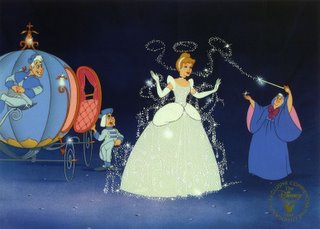 A while back my CPs and I realized we were all tapping into elements of popular fairy tales: Beauty and the Beast, Sleeping Beauty and (mine) Cinderella. We didn’t see it as a Bad Thing. These stories have something called “enduring appeal”. Nothing wrong with that!
A while back my CPs and I realized we were all tapping into elements of popular fairy tales: Beauty and the Beast, Sleeping Beauty and (mine) Cinderella. We didn’t see it as a Bad Thing. These stories have something called “enduring appeal”. Nothing wrong with that!
I’ve been thinking about Cinderella again (must be one of my favorites) and here are some of the reasons for her popularity:
- The idea of a magical night where one meets (and instantly recognizes) one’s soul-mate. Glass slipper optional.
- The whole rags-to-riches, ugliness-to-beauty transformation.
- The desire to be rescued from one’s humdrum existence, the whole “Calgon, take me away!” fantasy.
But the rescue fantasy can also be the downside of a Cinderella story. I enjoyed the classic Disney animated version, but have to admit the mice carried the story. As a child, I wondered if you got a Prince just for putting up with annoying relatives. Knowing I couldn’t have put up with that evil stepmother and mean stepsisters made me feel a bit . . . guilty.
That was before we writers were told it was Bad to have a Passive Heroine who puts up with a toxic situation rather than leave or change it.
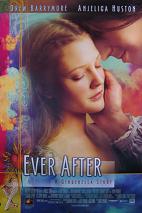 More recent retellings make an effort to reverse this. One of my favorite is the movie “Ever After” with Drew Barrymore. A plucky Cinderella, who has good reasons for staying with her family and does NOT meekly accept her fate (she punches out one evil stepsister, and rescues the hero from a band of brigands.)
More recent retellings make an effort to reverse this. One of my favorite is the movie “Ever After” with Drew Barrymore. A plucky Cinderella, who has good reasons for staying with her family and does NOT meekly accept her fate (she punches out one evil stepsister, and rescues the hero from a band of brigands.)
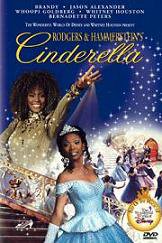 A more self-conscious effort came in Disney’s remake of Rodgers & Hammerstein’s Cinderella (the version with Brandy and Whitney Houston). Some people dissed this movie for its interracial cast (but it’s a fairy tale, right, folks?) I enjoyed it for the most part, and thought Pablo Montalban was particularly charming as the prince though Jason Alexander was equally annoying as the palace gofer. Back to the subject, though, in this remake they have Cinderella run away from her toxic family near the end. Of course, on the way out she meets up with the Prince.
A more self-conscious effort came in Disney’s remake of Rodgers & Hammerstein’s Cinderella (the version with Brandy and Whitney Houston). Some people dissed this movie for its interracial cast (but it’s a fairy tale, right, folks?) I enjoyed it for the most part, and thought Pablo Montalban was particularly charming as the prince though Jason Alexander was equally annoying as the palace gofer. Back to the subject, though, in this remake they have Cinderella run away from her toxic family near the end. Of course, on the way out she meets up with the Prince.
 One Cinderella retelling I thoroughly enjoyed was Gail Carson Levine’s ELLA ENCHANTED. The movie version was cute, but totally deviated from the book except for the main premise, that Ella struggled against an enchantment that forced her to obey any command from anyone. The book is a fun read, with an important message.
One Cinderella retelling I thoroughly enjoyed was Gail Carson Levine’s ELLA ENCHANTED. The movie version was cute, but totally deviated from the book except for the main premise, that Ella struggled against an enchantment that forced her to obey any command from anyone. The book is a fun read, with an important message.
On to some Regency-set romances with Cinderella elements.
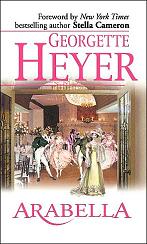 ARABELLA, by Georgette Heyer, is perhaps the classic, quintessential London Season story, where a heroine from a modest country family becomes the most sought-after belle in society. It’s great fun, but I have to say too that it’s been imitated far too many times. The other Cinderella element that’s become rather tired is the poor, unappreciated heroine whose mother (or stepmother) unfairly favors her supposedly more beautiful sister.
ARABELLA, by Georgette Heyer, is perhaps the classic, quintessential London Season story, where a heroine from a modest country family becomes the most sought-after belle in society. It’s great fun, but I have to say too that it’s been imitated far too many times. The other Cinderella element that’s become rather tired is the poor, unappreciated heroine whose mother (or stepmother) unfairly favors her supposedly more beautiful sister.
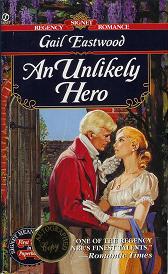 One story that flipped over the Cinderella concept is AN UNLIKELY HERO, by Gail Eastwood. The hero, Gilbey, is a soft-spoken, scholarly NICE guy who comes into his strength while aiding the heroine and her sister. Loved this one!
One story that flipped over the Cinderella concept is AN UNLIKELY HERO, by Gail Eastwood. The hero, Gilbey, is a soft-spoken, scholarly NICE guy who comes into his strength while aiding the heroine and her sister. Loved this one!
 A more obviously Cinderella-inspired story is ONE NIGHT OF PASSION, by Elizabeth Boyle. The story starts with the heroine seducing the hero at a Cyprian’s Ball. Though it doesn’t tap much deeper into the fairy tale, it’s a fun, quick read.
A more obviously Cinderella-inspired story is ONE NIGHT OF PASSION, by Elizabeth Boyle. The story starts with the heroine seducing the hero at a Cyprian’s Ball. Though it doesn’t tap much deeper into the fairy tale, it’s a fun, quick read.
So what do you like best/worst about the Cinderella fantasy? When does a Cinderella cross the line from being worthy to being a doormat? Is it going too far to have a kickbutt Cinderella instead?
What are your best/least favorite interpretations of Cinderella?
Elena
LADY DEARING’S MASQUERADE, RT Reviewers’ Choice Award nominee
www.elenagreene.com

I’ve read a bit about fairy tales and their origins, and I find it interesting that the passivity that we now denigrate in Cinderella was mostly a Victorian addition…the original Cinderella was not all that “sweet” and submissive!
One thing the Opies pointed out in their fairy tale scholarship was that the unvarying theme in all the versions of the Cinderella story (including the ones where it’s her father who’s the villain) is not that if one is poor and good one will be rewarded, or that if one is passive and good one is rewarded… No, Cinderella is always someone of high class (and worth) who is unfairly forced into a low position… What the prince (or whoever) does is RECOGNIZE the worth that she already has. She is not worthy of the prince because she is good, but because she is of high birth.
Now, obviously, the whole class thing doesn’t work for us so well nowadays…but I think this theme is still quite usable. I used it in my first (as yet unpublished) Regency, where my heroine is the capable and competent member of a lazy family…
I think a lot of us, in our own lives, end up in roles assigned to us (in our families, at work, and with friends). So if you’re officially the bossy one, or the lazy one, or the flake, or whatever, you can spend years or decades being totally unlike your label, and yet your family may not notice and revise the label…
But someone from the outside can take one look and say “but wait, I don’t see that at all.” 🙂
Anyway, that’s my version of the Cinderella story…
Cara
Julia Quinn’s An Offer from a Gentleman is the first Cinderella retelling that comes to mind. It was a fun read and classic Quinn.
A sort of reversal of the Cinderella story in which the hero is the one who is really the high born one is Judith Ivory’s The Proposition, which is also a retelling of Pygmalion. The hero, whose name escapes me, is a ratcatcher who is whipped into fashionable shape by the Agatha, a female Henry Higgins. Turns out that the hero is really the heir to a peerage…
I loved THE PROPOSITION, Mandacoll! Actually, I’ve loved everything I’ve read by Judith Ivory, she’s one of my favorites, and one who does a lot with fairy-tales. (Her best, IMO, was SLEEPING BEAUTY. BEAST was also great. I was a tiny bit let down by TP’s ending…)
When I was kid, I had a book of “real” Grimm’s fairy tales, including the Cinderella that featured delightfully gruesome details, such as the stepsisters cutting off bits of their feet to fit into the slipper. Of course, once the shoe filled up with blood they were busted. I’m just waiting for someone to do a romance like that. 🙂
You know, Amanda, I don’t think I’ve read Beast or Sleeping Beauty by Judith Ivory, though I’ve read everything else. I think I went on a Judith Ivory binge one summer and then forgot about her…need to add those to my TBR list…I was rather disappointed by the miracuous lost heir wrap up at the end of TP. I know part of the fun of fiction is that the end can be whatever the writer wants, but sometimes those miraculous endings just seem a little too easy.
Spoilers! Yikes! Oh well, I should have already read THE PROPOSAL by now, it’s on my TBR list. I will anyway even if there was a bit of deus ex machina in the ending.
Cara, it’s so interesting that the Victorians came up with the sweet, submissive stuff (not my style at all). I’d love to know your favorite books on the subject, as I find it so interesting.
Elena 🙂
Sorry, Elena! I hate spoilers! It is worth the read though!
Bad, mandacoll!
Elena, I’d highly recommend THE CLASSIC FAIRY TALES, by Iona and Peter Opie (1974, reprinted often — originally Oxford University Press, though perhaps reprinted by another as well.)
In their preface they say, “In the present volume we give the texts of twenty-four of the best-known fairy tales as they were first printed in English…” In addition to these reprinted stories, they also give the history of each story, plus a commentary.
It’s really fascinating reading, and not just for Regency research! They point out, for instance, that in some early versions of Cinderella, the very non-passive Cinderella murders her stepmother. 🙂
Cara
Angela Carter, one of my favorite writers, edited a collection of fairy tales for Virago Press, which is wonderful. And she also wrote a collection of retelling of fairy stories, including several versions of Beauty and the Beast, “The Bloody Chamber”–amazing stuff if you like revisionist, feminist interpretations, and wild, rich language.
I’m quite interested in the idea of myth and all that hero’s journey stuff–not that I ever do anything rather than dabble around the edges with it. I’m afraid if I analyze too much I’ll lose it. One thing I do find, though, is that at some point in the story I’ll realize, as you and your CPs did, Elena, that it’s a version of a very familiar story. My current one is a version of Orpheus and Euridice with a bit of Ariadne thrown in. Oops, that makes me sound far more cerebral and better read than I am. Let’s say I was very well read in my formative years and odds and ends have stayed with me.
Janet
I’m also very interested in myth and legend, and addicted to Joseph Campbell! I took as many “mythology” classes in college as I could. Of course such things seep into our writing, how could they not? Opera is also a great inspiration, I think. 🙂
I agree that fairy tales tap into some kind of enduring archetypes, which explains their continued appeal, even as society has radically changed around them. Cinderella, in particular, strikes a common chord: someone unfairly held back being recognized and raised above everyone else. And who doesn’t feel unfairly held back at least sometimes?!
I also have always loved The Thousand and One Nights, ever since I had a children’s version of the Arabian Nights as a boy. It’s surprising how many themes are echoed in both Scherezade’s tales and Western fairy tales, though of course there are many differences as well.
Todd-who-lives-in-a-fantasy-world-anyway